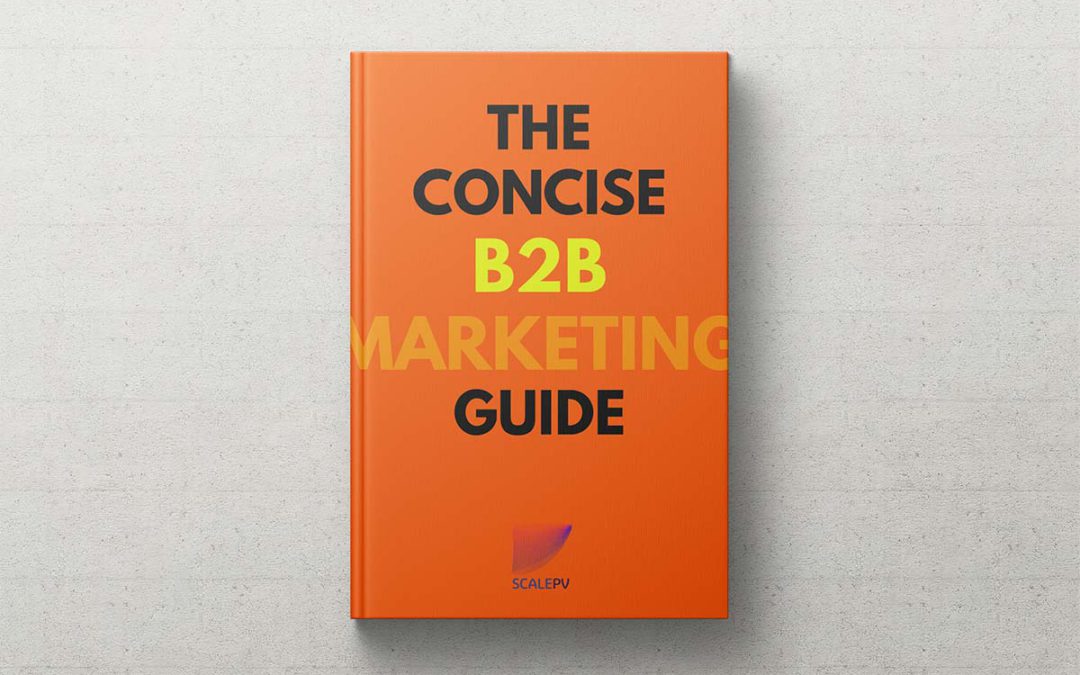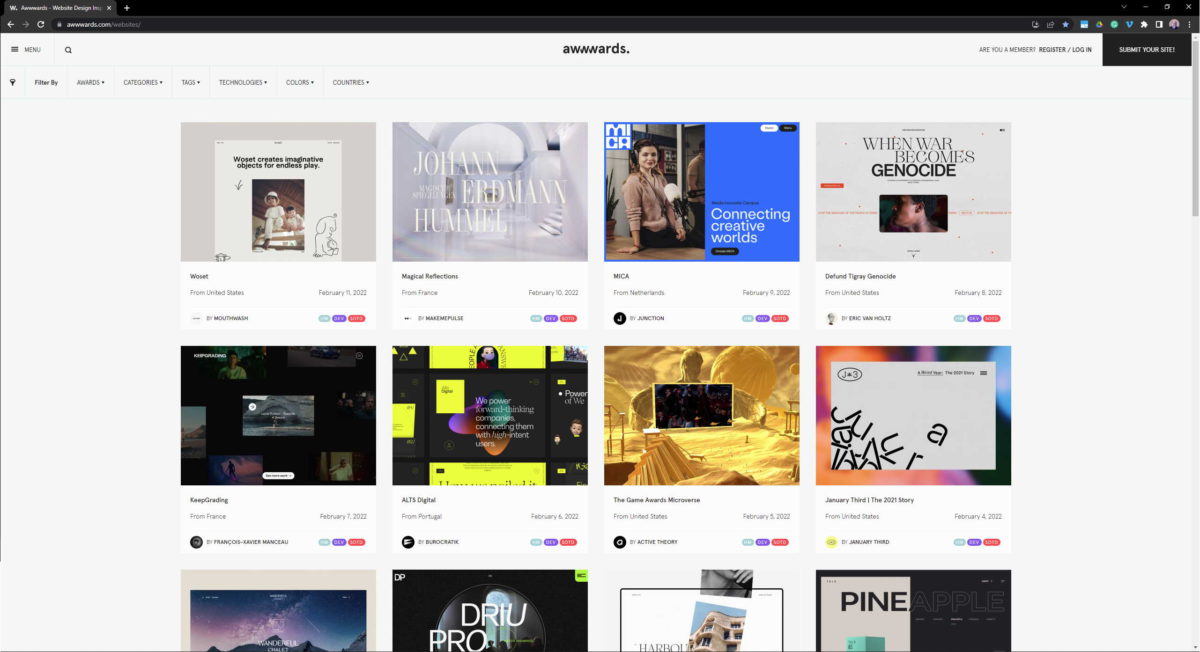Marketers must juggle a lot when designing their marketing strategy between creative needs, budget constraints, and channel decisions. That is why effective marketing is challenging to achieve.
However, the most significant determinant of marketing effectiveness is defining your audience. If you don’t target your buyer correctly or don’t understand his unique journey, your promotions and ads are likely to go unheeded. You may not be marketing at all.
One key aspect where the target audience varies is between consumers and businesses. Some businesses serve individual customers, while others serve businesses and organizations. Selling to businesses usually requires a ‘rational’ approach to move groups inside organizations to a purchase decision. Very different with individual consumers, so marketing to businesses is very different from marketing to individual consumers.
Therefore, there is an entirely different marketing method called B2B marketing, and to explain its current practices, we created this guide. By the end of this article, you will better understand B2B marketing, the most effective B2B marketing strategies, and how you can engage and transform your business audience.
What is B2B Marketing?
B2B marketing (business to business) refers to any marketing strategy or tactics targeted at a business or organization. Companies that sell products or services to other businesses or organizations (as opposed to consumers) usually use B2B marketing strategies and tactics.
The goal of B2B marketing is to inform other companies about your brand, the value of your product or service and convert them into customers. Salesforce is an example of a B2B marketing company.
Salesforce’s customers are companies other than individual consumers. As such, all their marketing efforts can be categorized as B2B.
B2B vs. B2C Marketing
B2B marketing and B2C (business to consumer) marketing differ in their strategies and applications and their audience, and how they communicate with them.
B2B marketing seeks to meet the needs, interests, and concerns of people who purchase for their organization (and not for themselves), making the organization a buyer.
Here are a few examples of B2B companies:
- An on-demand order fulfillment, warehousing, and screen-printing service (like Postalytics)
- A coworking space that leases office spaces to small companies, and remote teams (like Regus)
- A sales and marketing software company that sells customer relationship management tools, lead generation software, and other marketing tools to businesses and organizations (like Salesforce!)
B2C marketing seeks to meet the needs, interests, and concerns of consumers who shop on their behalf, thereby making a person a buyer.
Here are a few examples of B2C companies:
- An e-commerce retail company that sells to individuals (like Amazon)
- A store that sells t-shirts and other clothing and accessories (like Walmart)
- A video platform that sells streaming subscriptions (like Netflix)
Take a look at this chart comparing B2B and B2C customers.
| FOR B2B MARKETING | FOR B2C MARKETING | |
| Objective | Clients are focused on ROI, efficiency, and competence. | Customers are looking for opportunities and entertainment (which means marketing should be fun). |
| Motivation | Customers tend to be logical and seek financial incentives. | Customers are typically more driven by feelings. |
| Driving Forces | Customers want to get educated on the reasons for the purchase. | Customers don’t always need to be educated on purchasing the product or service. |
| Purchase Process | Clients love to work with account managers and salespeople. | Buyers typically prefer to shop directly. |
| People in the Purchase Process | Customers often need to consult with decision-makers and others in their line of business before making a purchase decision. | Customers rarely need to consult with others before making a purchasing decision. |
| Purpose | Customers choose long-term solutions, leading to longer sales cycles, longer contracts, and longer relationships with the company. | Customers do not necessarily seek long-term solutions or long-term relationships. |
However, as much as they differ, B2B and B2C also overlap in many ways. While Amazon sells to individual consumers, they also have a business division that sells to corporations. On the other hand, Postalytics offers businesses more than just order fulfillment and warehousing; they can also fulfill e-commerce print orders for individuals.
Although B2B and B2C marketing have different audiences, B2B marketers can always learn from B2C activities.
B2B Marketing Strategies
As mentioned above, marketing depends on its audience. Although B2B and B2C marketing are different, not all B2B marketing materials are the same. In this section, we will discuss various B2B marketing strategies you can implement to attract specific business audiences.
Before diving in, make sure you understand the B2B buyer journey. Pay attention to how each of these steps affects your marketing strategy and how you implement them.
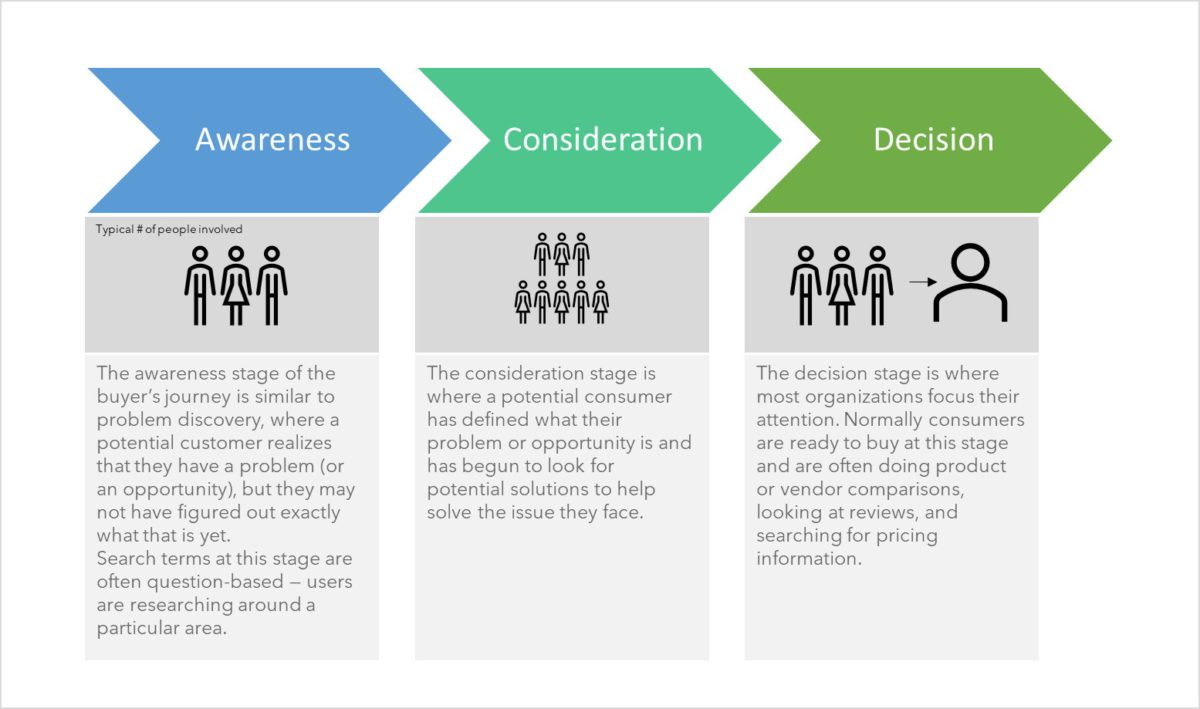
When you start defining a B2B marketing strategy, you need to take steps before directly implementing it.
1. Determine your brand positioning.
To create an effective strategy, you have to understand your brand positioning fully. This statement is the who, when, why, and how of your brand identity — or the way your brand is perceived through the eyes of the customer.
Devise a brand positioning statement that your team and prospective customers can believe in, and you’ll be ready for the next step.
2. Identify your target audience.
Find your target audience — or who’s looking for your brand’s products or services. That information will help you create buyer personas and understand how they make purchase decisions, a tool that’s extremely useful for any type of marketing.
3. Run a competitive analysis.
Research the market and discover what other companies offer your target audience through a market landscape competitor analysis. Watch for these items when researching competitors:
- Product and services offerings (features, pricing, etc.);
- Sales strategy and tactics; and
- Content marketing and social presence.
An overview of these elements can help you recognize your competitors’ strengths, weaknesses, opportunities, and threats, also called a SWOT analysis.
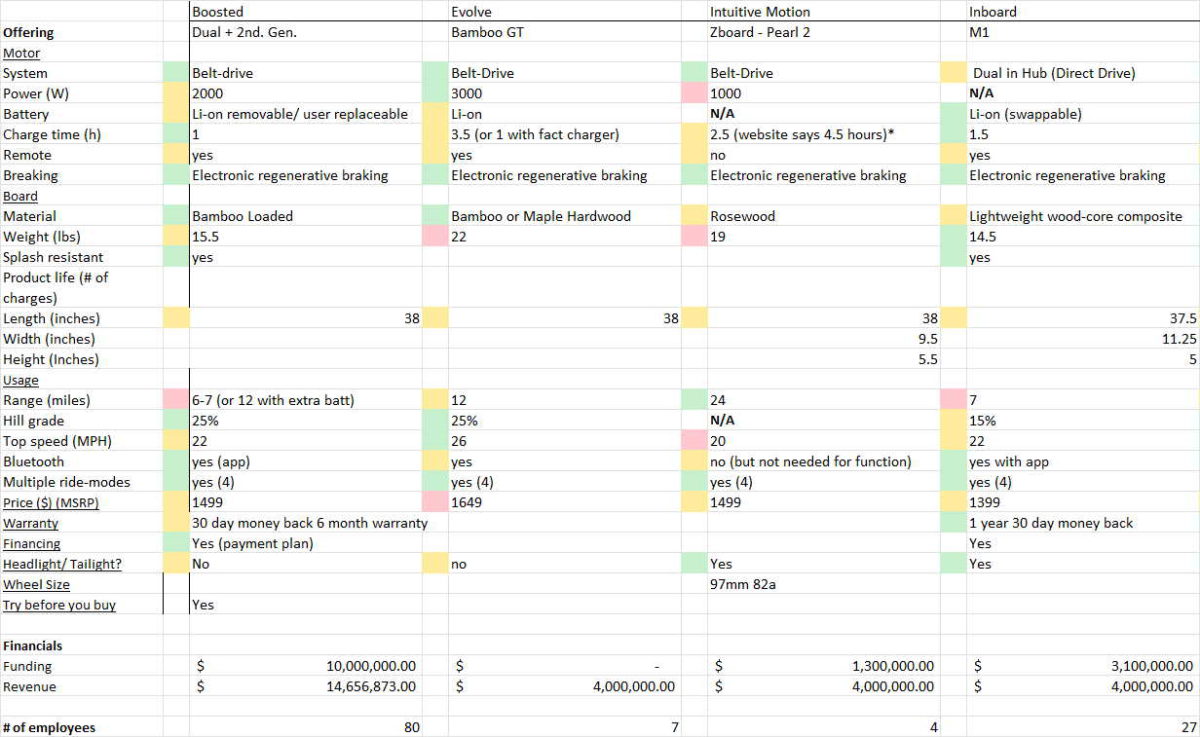
4. Examine the marketing channels
In your competitive analysis, you will see the different marketing channels your competitors are using successfully and the channels they were not using.
By following the above steps to start building your B2B marketing strategy, this is where you can diversify your B2B marketing portfolio and reach the right companies. The following categories are B2B marketing channels designed to connect you to your target audience.
B2B Email Marketing
Email marketing is a proven method of reaching both individual consumers and business customers.
Did you know that 93% of B2B marketers use email? Email leads to participation, which turns subscribers into potential customers and then customers. Unlike B2C customers who are better at responding to emotions and entertainment, B2B customers are looking for a logical and positive return on investment. Basically, they are asking: How can your business help my business grow?
For this reason, your email marketing needs to continually resonate with your business customers and focus on the things that matter to them, such as time, money, and resources. Email marketing is also a powerful vehicle for distributing your brand content. Today, with our inboxes constantly filled with floods of emails, it is more important than ever to create and send effective marketing emails.
B2B Email Marketing Best Practices
- Write ‘catching’ subject lines. Think of your email subject line as an online video trailer-if you cannot attract viewers with a two-minute clip (or, in this case, with a few words), don’t expect them to open and watch (or read) the full text. We recommend spending almost as much time on the subject line as the letter itself.
- Most of the time it is one call-to-action (CTA) per email. If you think you’ve received a very large number of emails, please check the call-to-action in these emails; some of them contain two, three, and sometimes as many as five different calls to action. Don’t make such a mistake because it will beg the question, “What should I click?” This will confuse your recipients. With an email call to action, you allow your audience to focus on the content of your email and ultimately on the action, a welcome relief from the frequent paralysis of today’s decision-making and analytics. The one exception to this rule is when you have multiple CTA as points of contact, like when your email is aimed at scheduling a first meeting or discovery call.
- Segment your email to reach the most relevant audience. Not every email you send will work for everyone on your list. Your followers may be at different stages of the buying journey or looking for different solutions. This is where segmentation of mailing lists comes in. Not only does it help you connect better with your audience, but it also gives your emails that personal feeling that says, “Hey, I’m listening to you, and I know what you’d like to see.” At any given time, consumers prefer high-quality email to quantity.
- Make sure your email designs are responsive. More than 80% of email users access the inbox through their mobile phones, and emails that cannot be displayed correctly on a mobile device are usually deleted within three seconds. Don’t let your email be one of them.
- Don’t be afraid of the cold email. Although inconvenient, the correct cold email can bring in new customers, just as cold selling can attract more new B2B customers.
Tip: You can’t send marketing emails without a recipient-these people make up your list. There are many simple ways to increase your mailing list. Start with the sign-up forms on your website home page, your About Us page, and your blog.
B2B Digital Marketing
Whether B2B or B2C, every business must have a digital presence that includes paid advertising, search engine optimization, a website, and any other place where your B2B business is active online. Let’s look at some tactics that can bolster your B2B digital marketing strategy.
1. Define your target audience.
A strong B2B digital marketing strategy starts with identifying your target audience or buyer persona. This demographic and psychographic information will be used in virtually all subsequent marketing efforts, ensuring that your digital content is consumed with the right eyes and ears (and that resources on your part are not wasted).
2. Create your website.
Second, digital marketing cannot work without an informative and engaging website. Over 80% of shoppers visit a website before making a purchase. In addition, since many key players (such as gatekeepers, decision-makers, and other people who need to be involved in a purchase) are often involved in a typical B2B sales cycle, websites are an easy and straightforward way for influencers to share information about your business, products or services.
For inspiration on how the best B2B websites are built to impress, check out https://www.awwwards.com.
3. Optimize your digital presence.
Your website should be more than informative and interesting, though … it should be discoverable. You can do this using in-page SEO and SEO techniques. These include everything from image alt text and meta descriptions (what visitors can see) to structured data and site speed (what visitors can’t see). Also at risk is off-page SEO, which refers to inbound linking and social media sharing strategies – search engine optimization strategies applied outside of your website.
4. Run paid media campaigns.
Finally, complement your digital presence with paid media, especially pay-per-click (PPC) advertising, which allows you to expose your content and brand to new audiences through search engines and other advertising platforms.
We recommend that you maximize your PPC investment by advertising more of your specific products or services, such as your brand identity, blog or social media content, or company slogan. The best way to see your paid ad ROI is to 1) embed the ideal customer profile data into your targeting and 2) increase the amount of content they are interested in. For example, it’s unlikely that a new consumer who has never heard of you will be looking for your product. They may be looking for a location-based solution or product feature.
To obtain the largest number of potential customers, it is necessary first to target the purchase categories related to the promotion of your products or services, targeting what we call in-market buyers.
B2B Content Marketing
We talked about B2B customers who are experience-driven, logical-driven, and desire to learn. What better marketing tool than B2B content marketing to meet these priorities? Traditional public relations marketing strategies interrupt consumers’ daily lives through promotional materials, while content marketing strategies add valuable information and inform consumers and this is exactly what B2B customers are looking for. Not to mention, content marketing supports SEO efforts, including predicting what your audience is looking for, helping them find your website and content, and potentially converting them into customers.
It’s important to note that content marketing is most effective when aligning content with different stages of the buyer’s journey.
As Craig Davis, former Chief Creative Officer at J. Walter Thompson, said: “We need to stop interrupting what people are interested in and be what people are interested in.”
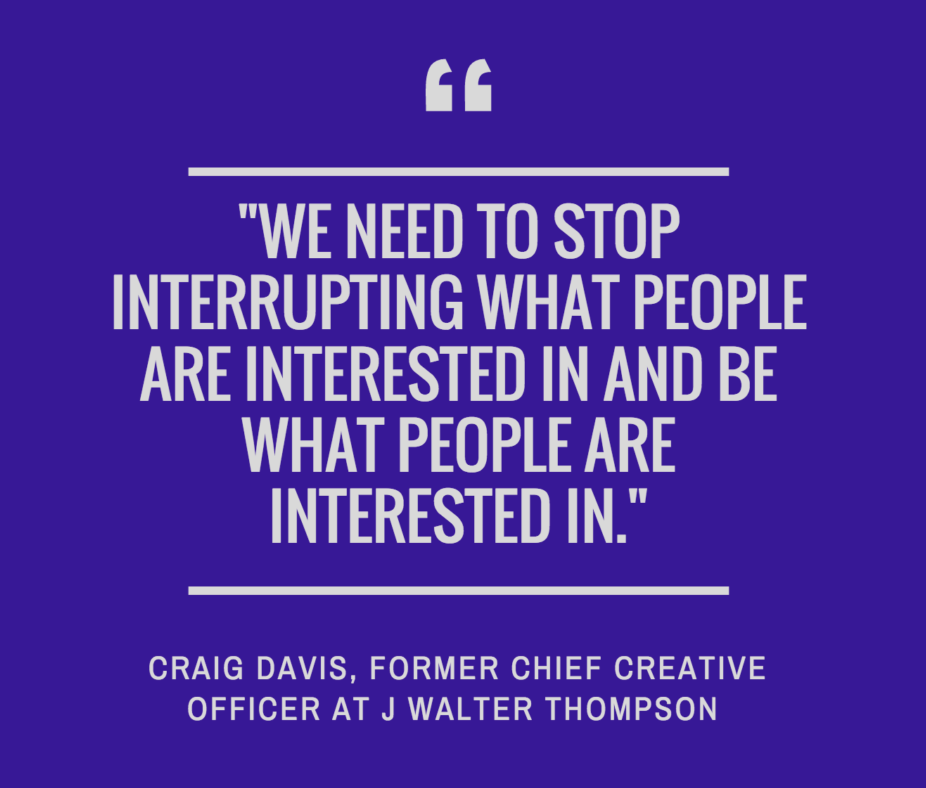
Davis also adds, “Audiences everywhere are tough. They don’t have time to be bored or brow-beaten by orthodox, old-fashioned advertising (content).”
In fact, 80% of business decision-makers prefer to get information from an article rather than an advertisement. Knowing this, I would say that you should invest the same (if not more) resources in your content marketing as you would in a traditional advertising strategy. Because the B2B buyer’s journey is slightly different than the B2C buyer’s journey (shorter sales cycles and fewer decision-makers), the content you create for your B2B content marketing strategy may be less like what is seen in B2C. There is a big difference, as pictured below:
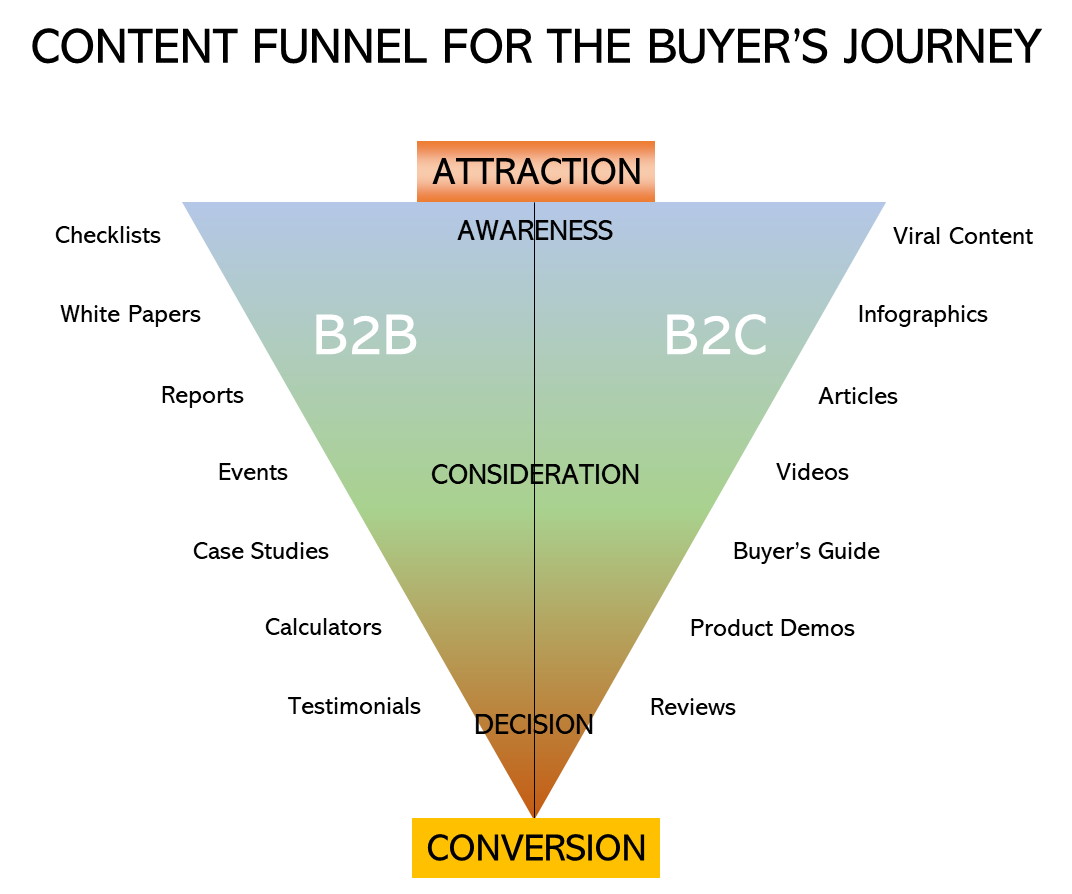
However, before you start creating content, I recommend that you create a corporate blog. Your blog will host all the content you create and serve as a base for readers to visit and subscribe.
B2B Social Media Marketing
Did you know that 75% of B2B shoppers and 84% of C-Suite executives use social media when making a purchase?
That’s right: Social media marketing isn’t just for brands that target individual consumers. However, many B2B companies are struggling with social media marketing. It can be more difficult to use social media to connect with corporate clients, especially since (as previously mentioned) there is usually a longer sales cycle and a longer chain of command. Honestly, B2B social media marketing might not be where the most leads are converting, and that’s okay. This will likely come into play early on in your customer’s buying journey.
Social media is a powerful tool for building brand awareness, personalizing your business online, and humanizing your business – all very powerful factors when it comes to marketing and reaching out to potential customers. Like email marketing, social media is also a very effective channel for sharing your content and enhancing the quality of your brand, which we know B2B customers value. While your social media accounts may not convert as often as your content or email marketing, they are just as important. This is where subscribers are just as valuable – you never know when they might turn into leads or customers.
Content shared by employee advocates gets eight times as much engagement as content shared by brands. Then, involve your employees in your B2B social media marketing strategy. Encourage them to create their own social media channels and share your company life. Create a cultural account to show what’s happening at work, not just what you’re selling. You never know: this can also attract strong talent.

Learn more about our outsourced Martech teams services and how we can help your B2B efforts here.

